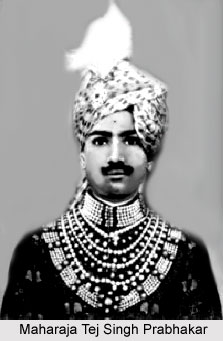 Tej Singh Prabhakar was the last ruling Maharaja of the princely state of Alwar, which is presently known as Alwar District in the state of Rajasthan in the northwest of India. He was a distant cousin of the preceding ruler Jai Singh Prabhakar who was exiled from the state of Alwar and was stripped of his rank, power and titles by the British Government for misconduct, cruelty and misdemeanor. Later Tej Singh was chosen by the British East India Company as the next Maharaja of Alwar.
Tej Singh Prabhakar was the last ruling Maharaja of the princely state of Alwar, which is presently known as Alwar District in the state of Rajasthan in the northwest of India. He was a distant cousin of the preceding ruler Jai Singh Prabhakar who was exiled from the state of Alwar and was stripped of his rank, power and titles by the British Government for misconduct, cruelty and misdemeanor. Later Tej Singh was chosen by the British East India Company as the next Maharaja of Alwar.
Rule of Tej Singh Prabhakar
He was a rather popular and efficient ruler who reigned over the territory from the year 1937 to 1947, when the country gained independence from the British administration. He was knighted in the year 1943. He strongly detested the growth of the Indian National Congress Party and was much loyal to the British Government. After the murder of Mahatma Gandhi, Tej Singh Prabhakar was detained by the Delhi authorities on the controversial charges of being involved in the assassination plot. Moreover, the state of Alwar was seized by the Government of India.
In the year 1948, Alwar was merged with the princely states of Eastern Rajputana, which formed the Matsya Union. It was later merged again with the Greater Rajasthan in 1949. Sir Tej Singh Prabhakar retired to Delhi in the year 1948. Later in 1971, he stripped of his titles and styles, due to the mass de-recognisation of the royal families under the regime of Indira Gandhi.
Personal Life of Tej Singh Prabhakar
Maharaja Sir Tej Singh Prabhakar was married to Her Highness Maharani Shri Chand Kanwarji Sahiba of Jodhpur in 1931. The couple had three daughters and two sons, namely Maharaj Kumari Baiji Lal Bhanu Kumari Sahiba, Maharaj Kumari Baiji Lal Pratap Kumari Sahiba, Maharaj Shri Yashwant Singhji Sahib and Yuvraj Shri Pratap Singh Sahib.
In 1976, during the period of Indian Emergency, tax inspectors searched the royal palaces in Alwar and during these raids, Tej Singh`s eldest son and heir was mysteriously murdered. Maharaja Tej Singh Prabhakar of Alwar died at the age of 97 on 15 February 2009 at Alwar House, New Delhi, after a titular reign of 72 years. He was cremated at Delhi. Jitendra Pratap Singh, his grandson, succeeded him as the titular Maharaja of Alwar.
Titles of Tej Singh Prabhakar
Tej Singh Prabhakar, Maharaja of the princely state of Alwar held numerous titles and styles through out his reign. These are mentioned as follows-
* Sri Tej Singh (1911- 1937)
* His Highness Raj Rishi Sri Sawai Maharaja Tej Singh Veerendra Shiromani Dev Bharat Prabhakar Bahadur, Maharaja of Alwar (1937- 1941)
* Lieutenant His Highness Raj Rishi Sri Sawai Maharaja Tej Singh Veerendra Shiromani Dev Bharat Prabhakar Bahadur, Maharaja of Alwar (1941- 1943)
* Lieutenant His Highness Raj Rishi Sri Sawai Maharaja Sir Tej Singh Veerendra Shiromani Dev Bharat Prabhakar Bahadur, Maharaja of Alwar, KCSI (1943- 1944)
* Captain His Highness Raj Rishi Sri Sawai Maharaja Sir Tej Singh Veerendra Shiromani Dev Bharat Prabhakar Bahadur, Maharaja of Alwar, KCSI (1944- 1945)
* Lieutenant-Colonel His Highness Raj Rishi Sri Sawai Maharaja Sir Tej Singh Veerendra Shiromani Dev Bharat Prabhakar Bahadur, Maharaja of Alwar, KCSI (1945- 1946)
* Colonel His Highness Raj Rishi Sri Sawai Maharaja Sir Tej Singh Veerendra Shiromani Dev Bharat Prabhakar Bahadur, Maharaja of Alwar, KCSI (1946- 2009)
Honours of Tej Singh Prabhakar
Maharaja Tej Singh Prabhakar was honoured several times, which are discussed below-
* King George V Silver Jubilee Medal (1935)
* King George VI Coronation Medal (1937)
* Knight Commander of the Order of the Star of India- KCSI (1943)
* 1939- 1945 War Medal (1945)
* Africa Star (1945)
* Italy Star (1945)
* 1939- 1945 Star (1945)
* Indian Independence Medal (1947)



















